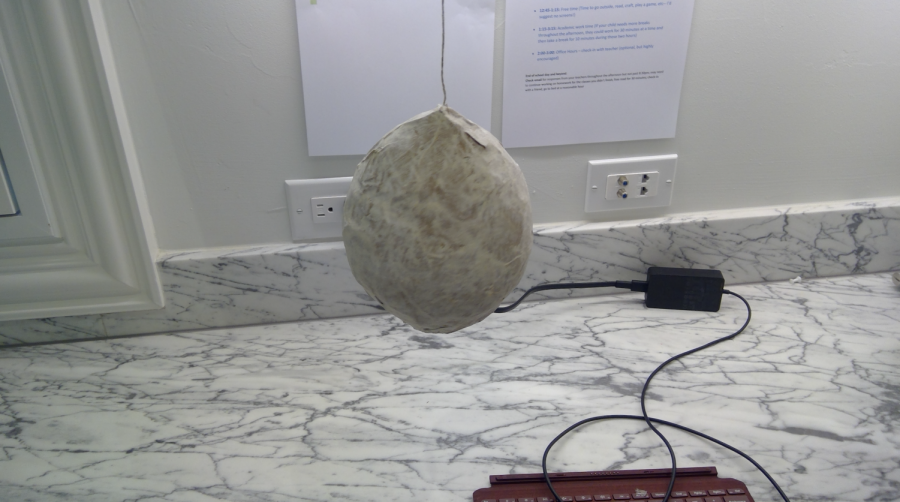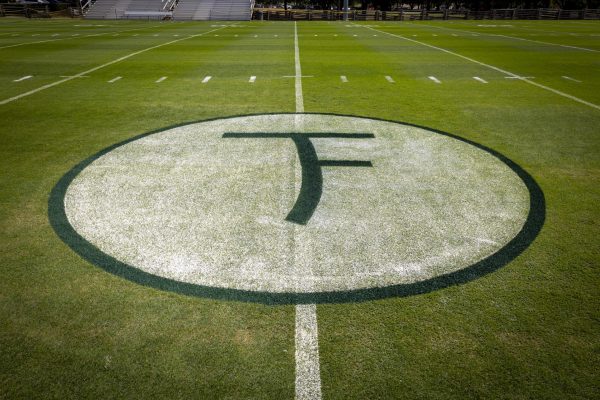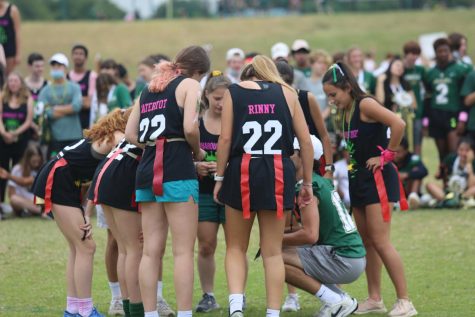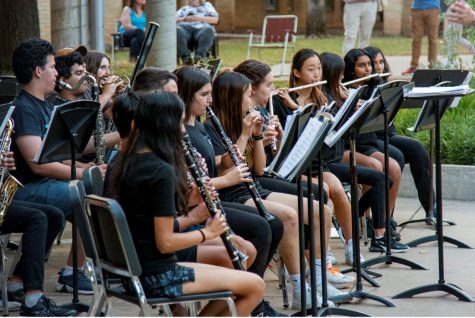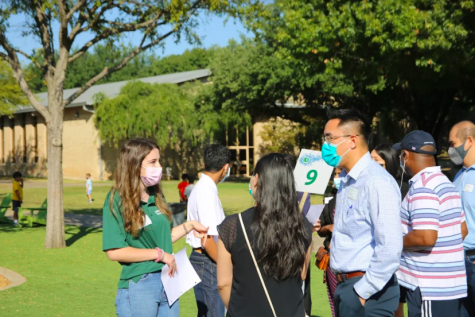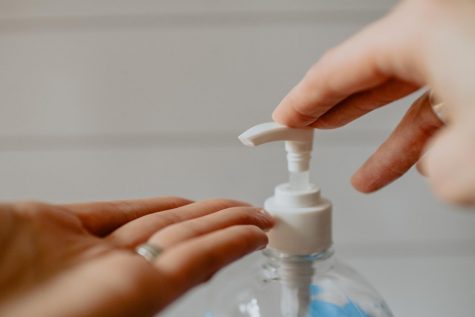How COVID-19 Affects the Arts
As the COVID-19 outbreak spread in early March, Greenhill teachers started to prepare to adapt their classes to online platforms.
Many fine arts teachers have had to think outside the box to transform their classes, especially since many fine arts classes revolve around a space to create, rehearse and perform. “So much of what we do in fine arts is engagement,” said Head of Fine Arts Terry Martin. “While there are physical activities, the biggest part is trying to get students to explore their own creativity and their own imagination. Everything that we have talked about doing online is to continue that aspect of the classes.”
Nearly two months later, the forced shift to online instruction is nearing an end. Students and teachers have gained new skills while testing the limits of distance learning in their various creative disciplines.
3-D Art
Middle School and Upper School 3-D art teacher Paige Furr teaches eight classes and two Advanced Placement (AP) tutorials. Her first assignment to all of her students was to have them design a workspace.
To get the students to continue their work with limited materials, Furr has reworked their curriculum. She has had classes work with do-it-yourself papier mache and create armatures, which are frameworks on which a sculpture is molded, and found-object assemblages, which involves putting various everyday objects together to compose a piece. She started posting tutorials on YouTube and creating assignments for the students to follow. In class, she checks in with her students and has them show what they are working on.
“The only way I could really demo what I was doing without being distracted was to create videos and upload them,” said Furr. “One of my colleagues suggested that I use YouTube, which I had never used before… I’m seriously an analog person so I had never edited videos before. It’s definitely been a learning curve for me.”
Studio Art, “Cavalcade” and “Montage”
Lesley Rucker, Upper School and AP Studio Art Instructor and “Cavalcade” and “Montage” advisor has also had to adapt many classes. She teaches multiple Upper School Studio Art courses, Yearbook and Montage and one class each in seventh and eighth grade. During online classes so far, she has been meeting with students, answering questions and looking at progress.
“The biggest challenge teaching from home is not having the one-on-one in person conversations,” said Rucker. “We’re trying sharing work during meetings and that’s good but not the same as seeing the work in person as sometimes the intricate detail might be hard to see. I think the students are doing well. This is new and challenging for all and I appreciate the effort each student is making.”
The COVID-19 outbreak has also affected the publications that she advises. Rucker has worked with the Technology Department to give all students access to their shared drives. Typically, the yearbook would have been finished by April. . Many stories had to be re-thought and redesigned as performances, games and events were canceled. The editor, section editors and staff have worked on creative ideas and ways to add to the publication, given the events of the past several weeks.
The yearbook was finally completed in early May.
The editors of “Montage” have been able to continue to view submissions and work independently on pages. It may be a smaller magazine this year, but it will still continue to highlight the written and visual talent of Upper School students, Rucker said.
Photography
The lack of materials at home has also impacted the way photography classes run. For example, Honors Photography students don’t have access to the campus darkroom.
“A lot of my work is in the form of collages, so I’ve been able to start some pretty cool projects with materials I’ve found around the house,” said junior Josh Flowers. “But it’s hard incorporating my photography into these works because the subject matter is so limited. . Right before the break we were about to start creating ambrotypes, which are prints on glass. I was really looking forward to experimenting with the new medium, but now I won’t be able to for who knows how long.”
https://www.instagram.com/p/B_qvgrGH_N0/
Drama and Theatre
Online acting courses have caused Upper School Drama and Theatre teacher Valerie Hauss-Smith to rethink performances. Hauss-Smith teaches an advanced acting class, spring production lab, a yearlong company class and a student production class.
The company class was originally going to write and perform a 25- to 30-minute piece at the Independent Schools Association of the Southwest Arts Festival (ISAS) and on campus. The class decided to keep writing the script, but instead of performing the piece live they decided to create a podcast. The students have been learning the Foley technique, which involves adding sound effects post production, to enhance the piece. The director’s job is now to record everyone and edit the podcast, while the rest of the team will work on advertising.
The student production class is adapting their two-person show. Currently, the two potential solutions are a live staged reading through an online platform, or they could change the story and have it take place in the present where one character hacks the other’s computer.
In her other classes, students are submitting their monologues to other theaters. During classes Hauss-Smith works one on one with students, and then students perform for their classes.
“It took a lot of thinking outside of the box,” said Hauss-Smith. “We want to make sure that this can happen during class time, and we want to make it fun and interesting.”
Orchestra and Strings
Middle School and Upper School Orchestra and Strings teacher Nick Paraskevas said that his main goal is maintaining one-on-one contact with as many students as possible. He teachers the chamber orchestra and teaches six Middle School classes. During synchronous classes, the focus is touching base to make sure everyone has their music and instruments.
“What we are doing now is not much different than what we do all the time, where we prepare individually so that when we come together, we will be able to perform,” said Paraskevas.
Before classes shifted to online, chamber orchestra was working on pieces to perform at ISAS, end of year concerts, baccalaureate and state-level solo and ensemble competitions. Paraskevas still hopes to find a venue where those pieces can be performed. More recently, students have shifted their focus to working in small ensemble groups.
“When we are able to work together, through the aid of technology, it’s going to be a lot easier to work with trios and quartets,” said Paraskevas. “The way we learn musicianship best is by playing music with one another. It’s not only the best way to learn, but it’s also the biggest joy, so playing together is definitely a priority for us.”
Choir
Online classes have also been an adjustment for Fine Arts students.
Junior Shreya Saxena is disappointed that she will not be able to perform with the choir at ISAS or at their spring concert, which was organized after the news of the competition’s cancellation.
“It’s definitely disappointing not being able to perform with the other members in choir, but we are trying to make the best out of the current situation,” said Saxena. “I am still able to learn about other aspects of choir and music during class, which is very interesting.”
Not only were performances canceled, but online choir classes are different than what would normally happen when all members were able to sing together.
“In choir, it is essential for singers to be in close proximity for our voices to blend together naturally,” said Saxena. “Now, with social distancing in place, it is obviously impossible. Typically, during online classes, we begin with individual vocal warmups with everyone on mute while Dr. [Lucik] Aprahamian leads us. This is followed by learning theory, sharing choir knowledge or watching online performances of other virtual choirs.”
Band
Another casualty of the flurry of cancellations is Band’s end of year Jazz Night. Band practices have also had to change.
“During band online classes, we take attendance and talk about our weeks, then Mr. Donnell gives us upcoming playing assignments, such as recordings, and checks in on us to make sure that we are practicing,” said junior Anagha Gouru. “We do not practice together on Microsoft Teams as that would be very chaotic, but Mr. Donnell encourages us to use SmartMusic to continue practicing our pieces. Through playing assignments with SmartMusic, we are able to get an experience similar to playing together.”
Debate
Gouru is also a member of the varsity Debate team, whose competitive season has ended.
“We have started planning for next year’s topic and receive lectures from Mr. [Eric] Forslund about important debate concepts,” said Gouru. “These classes are actually very similar to what we normally do, since we have lectures normally and class discussions, which we are able to do on Teams. Next week, we will be trying a practice debate using Microsoft Teams, I am excited to see how it will turn out!”
Dance Company
The lack of togetherness in online classes has also changed the way the Dance Company runs. Both ISAS and the dance performance were canceled. Junior Alison Thieberg said that during the days that Dance Company meets, each member does a full body warmup and stretch. On asynchronous class days members do an at-home video workout and complete some homework assignments, such as creating dance photos or making a dance.
“I am trying to make the most of online dance classes,” said Thieberg. “It can be very difficult to stay focused. When you are in a room full of other people and you are all doing a plank, you don’t want to fall. But when you are home alone in your room with your camera turned off, it can be difficult because you are no longer motivated to hold the plank. This has probably been my greatest test of self-discipline.”
Improv Troupe
Working together online has also proven difficult for the Improv Troupe. Improv is completely based on interacting with each another physically, so the troupe has been unable to run any of their games or build scenes with each another. Currently, the troupe members work individually to develop characters and accents.
“I can’t believe I’m saying this, but I actually miss waking up at 7:00am for improv with some of my best friends,” said Flowers.
“We all need the arts”
Working from home has not just impacted teaching classes, but has impacted some teachers’ independent work as well. Most of Furr’s work is ceramic work that requires a kiln, which she does not have at home.
“My work prior to this happening really reflects on the digital age versus the analog,” said Furr. “Now that our society has gone digital, I see it really affecting my work. Actually, I bought a bunch of jewelry supplies to create small metal boxes and deal with the conceptual idea of containment.”
Despite the fact that arts classes have adapted to the new online platform, students and teachers still miss being at school.
“There is something about being in the same space or in the same classroom that makes us something greater than when we are by ourselves,” said Martin. “While we are doing a good job, I think I miss that give and take of energy, and that excitement of being together on a regular basis. That’s the hardest part for me.”
Students also miss daily interactions with each other while in class.
“The most difficult part would be missing the physical interaction with my peers that I get during a typical school day,” said Saxena. “While I still get to communicate with my teachers and classmates virtually, it lacks the aspect of genuine human contact. Also, being confined to one area for an extended period of time can get lonely — I miss going out and exploring my community with friends and family.”
All fine arts teachers agree that being creative at home can help everyone, not just arts students, get through this tough time.
“Creating art, whether painting, drawing or just doodling on a piece of paper or the borders of an assignment notebook can offer an escape and take you away from the things around you,” said Rucker. “That, to me, is the silver lining. Artist expression can help work through fears and anxiety, problem solving in other classes and allow the artist to just be.”
Hauss-Smith also agrees that the arts are vital during this time.
“Everywhere else, people are turning to the arts to express themselves right now,” said Hauss-Smith. “People are writing songs and dancing… neighbors are going out onto their balconies and singing songs together. That’s something that is inspiring and puts things in perspective. In order to make it through this we all need the arts – as comfort, as support and as a way to express ourselves.”

